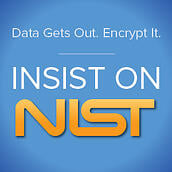What is NIST?
 The National Institute of Standards and Technology (NIST) is a US government agency that is a part of the Department of Commerce. The NIST sets non-military government standards for a wide variety of techn ologies including data encryption. Because the NIST uses an open and professional process to establish standards, the private sector usually adopts NIST standards for commercial use. The NIST is one of the most trusted sources for technology standards.
The National Institute of Standards and Technology (NIST) is a US government agency that is a part of the Department of Commerce. The NIST sets non-military government standards for a wide variety of techn ologies including data encryption. Because the NIST uses an open and professional process to establish standards, the private sector usually adopts NIST standards for commercial use. The NIST is one of the most trusted sources for technology standards.
What is AES?
 The Advanced Encryption Standard (AES) is the standard for data encryption adopted by the NIST in 2001. This encryption standard replaced the earlier Data Encryption Standard (DES). The DES encryption standard became weaker due to the advancing power of computer systems. The NIST began a process in the late 1990’s to find a replacement for DES. After a lengthy examination of several alternatives, the AES standard for encryption was adopted and codified as FIPS-197. AES encryption is now the de-facto standard for strong data encryption.
The Advanced Encryption Standard (AES) is the standard for data encryption adopted by the NIST in 2001. This encryption standard replaced the earlier Data Encryption Standard (DES). The DES encryption standard became weaker due to the advancing power of computer systems. The NIST began a process in the late 1990’s to find a replacement for DES. After a lengthy examination of several alternatives, the AES standard for encryption was adopted and codified as FIPS-197. AES encryption is now the de-facto standard for strong data encryption.
What is AES Validation Testing?
NIST sets the standard for AES encryption testing, and charters independent labs to administer and oversee the testing process. Through the National Voluntary Laboratory Accreditation Program (NVLAP) the NIST certifies independent testing labs for the Cryptographic Module Validation Program (CMVP). Data security software vendors administer the tests, validate the results, and submit the results to the NIST for acceptance. Software vendors work with an independent certification laboratory and not with the NIST directly.
The NIST established five methods, or modes, of encryption that can be used with AES. These are Electronic Code Book (ECB), Cipher Block Chaining (CBC), Counter (CTR), Output Feed Back (OFB), and Cipher Feed Back (CFB) modes. There are separate tests for each mode. A software vendor can choose to validate on only one mode, a subset of the five modes, or all modes of encryption. In addition, the NIST defines three key sizes for encryption: 128-bit, 192-bit, and 256-bit keys. A software vendor can choose from one to three key sizes to certify.
Most software vendors choose to certify just one or two modes of encryption, and on one key size. The Alliance AES Encryption products are certified on ALL five modes of encryption, and all three key sizes.
Certification Means Strong Encryption
NIST certification is your assurance that a vendor’s AES encryption solution implements data encryption the right way. There are many ways to use encryption and a wide variety of modes of encryption. Improperly implemented solutions may work for one type of task, but fail under different application requirements. All software vendors claim they implement strong encryption. Can they prove it? Ask them for their NIST certification.
Certification Means Compatibility
One of the biggest challenges facing Enterprise customers is encrypting and decrypting data on a variety of platforms. Data may be encrypted in an Oracle database, then transferred to Microsoft SQL Server, then to an IBM i (AS/400) platform. Computer vendors use different methods of encryption, and different modes of encryption. How can you be sure that your encryption solution will be able to handle all of your requirements?
The NIST certification provides the assurance you need that your software is up to the task. Certified software must work the same way for all of the NIST defined encryption tasks.
The Alliance AES solutions provide even more assurance of compatibility – Alliance AES solutions are certified on all key sizes and all modes of encryption. No other data security vendor provides this level of certified support.
Alliance AES Encryption on Every Enterprise Platform
 The modern Enterprise uses a wide variety of server platforms from a number of different vendors. In addition, data is exchanged with customers, vendors, and service provides outside the organization. To meet these challenges the Alliance AES Encryption products are certified and available on all Enterprise platforms including:
The modern Enterprise uses a wide variety of server platforms from a number of different vendors. In addition, data is exchanged with customers, vendors, and service provides outside the organization. To meet these challenges the Alliance AES Encryption products are certified and available on all Enterprise platforms including:
• Microsoft Windows (2000/XP/2003)
• Linux (SUSE and Red Hat, on Intel and POWER)
• UNIX (AIX, Solaris)
• IBM i (AS/400, iSeries)
• IBM z (mainframe)
All of the certified Alliance AES encryption solutions work the same way on every platform.
Townsend Security is currently offering a free 30-day evaluation of the Alliance AES encryption solution for your platform.


 Organizations need to comply with an increasing number of data privacy regulations. In addition to regulations such as PCI, HIPAA/HITECH, GLBA/FFIEC, and Sarbanes-Oxley, states are passing their own privacy laws. For example, Massachusetts says that if you are doing business with anyone in their state, you must comply with their privacy law – even if your business is located across the country.
Organizations need to comply with an increasing number of data privacy regulations. In addition to regulations such as PCI, HIPAA/HITECH, GLBA/FFIEC, and Sarbanes-Oxley, states are passing their own privacy laws. For example, Massachusetts says that if you are doing business with anyone in their state, you must comply with their privacy law – even if your business is located across the country. 


 As day three of the RSA Conference 2011 begins, it marks the half-way point through the largest data security tradeshow that the industry has to offer. Walking into the show you would be hard pressed to tell whether you walked into a security show or a grown up play-yard. Look to left you see sumo wrestlers, looking ahead there are unicycles weaving the crowd, and to the right are pirates handing out candy. And to top it all off, each night ends with beer, wine, and appetizers for all attendees. Who wouldn’t want to attend the RSA Conference 2011??!!
As day three of the RSA Conference 2011 begins, it marks the half-way point through the largest data security tradeshow that the industry has to offer. Walking into the show you would be hard pressed to tell whether you walked into a security show or a grown up play-yard. Look to left you see sumo wrestlers, looking ahead there are unicycles weaving the crowd, and to the right are pirates handing out candy. And to top it all off, each night ends with beer, wine, and appetizers for all attendees. Who wouldn’t want to attend the RSA Conference 2011??!! In our encryption practice we often help customers integrate the exchange of encrypted data between different applications within the organization, and between their own applications and a vendor’s or customer’s application. It is truly amazing to me how often we encounter non-standard encryption that makes this integration very difficult. The problem is not the lack of standards for encryption. Most compliance regulations provide clear guidance and references to encryption standards. Here is what the PCI Data Security Standard (PCI DSS) Navigation Guide says about encryption (my emphasis):
In our encryption practice we often help customers integrate the exchange of encrypted data between different applications within the organization, and between their own applications and a vendor’s or customer’s application. It is truly amazing to me how often we encounter non-standard encryption that makes this integration very difficult. The problem is not the lack of standards for encryption. Most compliance regulations provide clear guidance and references to encryption standards. Here is what the PCI Data Security Standard (PCI DSS) Navigation Guide says about encryption (my emphasis): One clear direction I’ve observed over the last few months is the focus of QSA auditors and other security professionals on the protection of sensitive data AFTER it traverses the Internet and then lands in a database on a hard disk drive. We have really good ways of protecting data in transit using 128-bit SSL encryption. For example, the web protocols HTTPS and FTPS provide for the ability to encrypt the data in transit, and Secure Shell SSH also provides strong encryption. But after the data reaches the end point of its journey it lands on a hard drive somewhere, and it is often exposed to loss at that point. I believe that’s why security auditors are putting a lot of emphasis now on making sure that data is encrypted when it hits a hard drive.
One clear direction I’ve observed over the last few months is the focus of QSA auditors and other security professionals on the protection of sensitive data AFTER it traverses the Internet and then lands in a database on a hard disk drive. We have really good ways of protecting data in transit using 128-bit SSL encryption. For example, the web protocols HTTPS and FTPS provide for the ability to encrypt the data in transit, and Secure Shell SSH also provides strong encryption. But after the data reaches the end point of its journey it lands on a hard drive somewhere, and it is often exposed to loss at that point. I believe that’s why security auditors are putting a lot of emphasis now on making sure that data is encrypted when it hits a hard drive.